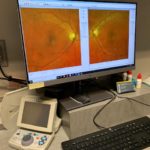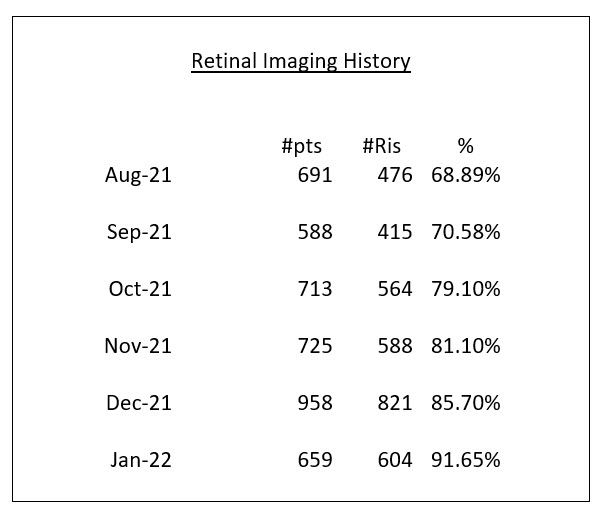
A display screen in one of Dr. Krivacic’s exam rooms. Dr. Krivacic says patients benefit greatly from being able to see their retina photos during their exam, and the practice benefits from the added revenues generated from use of the retinal camera.
By Ken Krivacic, OD, MBA
March 16, 2022
When you woke up this morning, did you have to think about shutting off your alarm or did your hand automatically push the button? Did you have to think about what to do next or did you just head to your morning shower? When you drove to your office, did you have to think about how to get there?
What am I getting at here and what does that have to do with increasing retinal imaging in your practice? In this article I want to show you how we went from doing retinal images on less than 70 percent of our patients to over 90 percent in six months.
We all know that retinal images are great for documentation and can be a good practice builder when presented correctly. In addition to benefiting patients by helping the doctor catch eye disease, and sometimes systemic diseases, at an early stage, capturing retinal photos helps the practice financially.
The hard part is figuring out how to get a large majority of our patients to elect to have these images taken. Setting goals and changing habits can help you capture a much higher percentage of these photos.
Setting the Goal
We have a relatively large practice with four ODs that amount to three full-time equivalent doctors since we all don’t work every day. We practice general optometry with an emphasis on contact lenses. The majority of the retinal images (>95 percent) are screening images for which the patient pays an out-of-pocket fee of $39. Historically we averaged just under a 70 percent usage of patients electing to have these images taken.
About six months ago, new management set a 78 percent monthly image usage as our goal so that our techs could attain a monthly bonus. How were we going to get there? Sure, it’s easy to set a goal – but getting there is another matter altogether.
Here is a table of our results over the last six months:

To achieve a large goal, it helps to start by making small changes and building on them. So, we took seven key steps and tracked what we were doing daily. This helped us get up to speed and not be paralyzed by looking at a large goal. We wanted to develop a habit.
As Charles Duhigg wrote in The Power of Habit, “Habits are powerful, but delicate. They can emerge outside our consciousness or can be deliberately designed. They often occur without our permission but can be reshaped by fiddling with their parts. They shape our lives far more than we realize—they are so strong, in fact, that they cause our brains to cling to them at the exclusion of all else, including common sense.”i
Here are the key steps we took toward our goal:
Educated Staff
Before expecting staff to present imaging to patients, the staff needs to understand the importance and benefits of the images. We took time to explain why the photos help us as doctors and how the photos benefit the patient. It can be as simple as reviewing sample images with staff and having them understand that a “picture is worth a thousand words.”
Wrote a Script
We wrote a script that is short and distinct and explains to the patient the benefits of the images. Anything that can be done to make the process more of a habit, so that staff doesn’t have to think as much, makes the process easier for them.
The script is as follows:
Mr./Ms.________, the doctors recommend you get a digital image taken of the inside of the eye. This helps them see the back of the eyes, look for disease and is a great way to document what the inside of the eye looks like for future reference. In the exam room you will be able to see what the inside of your own eye looks like. It is the best way to monitor changes in your eye health over time. While Dr. _____ feels that this is an extremely valuable addition to your eye health assessment, it is currently not covered by insurance and does have a fee of $39. Can we get started?
Refined the Script
After using the initial script, we met to discuss and brainstormed what worked and what didn’t. We then revised the script to make it simpler and easier to present. Each tech now has their own slightly modified version of the original that works best for them.
Other Articles to Explore
Tracked Numbers Daily
Each day the number of images taken versus the number of exams performed was shared with staff. The old saying, “What gets measured, gets done,” tends to hold in most cases. Just reviewing the numbers and celebrating the incremental increases has a tendency to build upon itself.
Doctors Educated Patients
The staff has already educated the patient about the benefits of the images. It’s now your turn as a doctor to reinforce that in the exam room. We review the images in the exam room on our monitors and I make sure to tell patients that the best way to track any changes inside their eyes is to compare images from year to year. The wording I use is: “It’s so much easier for me to compare these photos of the inside of your eyes from year to year as opposed to me looking at my notes of what your eyes looked like.”
Thanked Patients
It’s important to thank your patients for taking the extra step and having the images taken. I use a simple piggyback on the sentence and add, “I appreciate you having these photos taken today.”
Established a Habit
Establish a habit with yourself, your staff and your patients. When it becomes a habit, it will become second nature and the process will operate more seamlessly and feel more natural.
Duhigg describes forming a habit as a loop. He writes: “This process within our brains is a three-step loop. First, there is a cue, a trigger that tells the brain to go into automatic mode and which habit to use. Then there is the routine, which can be physical or mental or emotional. Finally, there is a reward, which helps your brain figure out if this particular loop is worth remembering for the future.”
He continues: “Over time, this loop-cue, routine, reward; cue, routine, reward-becomes more and more automatic.”
Use this process to enable your practice to operate more smoothly, not just in presenting retinal images but all aspects of what you do daily. Habits powerfully influence our automatic behavior.”i
References
i. The Power of Habit – Chales Duhigg 2014 Random House
 Ken Krivacic, OD, MBA, practices at Las Colinas Vision Center in Irving, Texas. To contact him: kkrivacic@aol.com.
Ken Krivacic, OD, MBA, practices at Las Colinas Vision Center in Irving, Texas. To contact him: kkrivacic@aol.com.

























